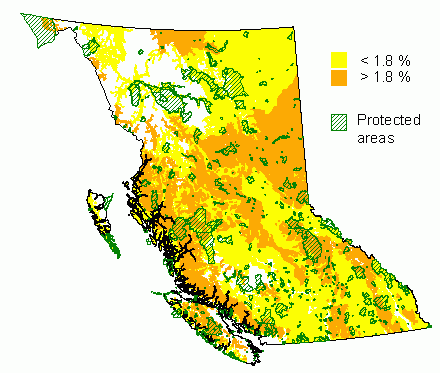Sitka alder
Alnus viridis (Chaix.) D.C.
Introduction
Sitka alder is an early successional deciduous shrub or, sometimes, a small tree. Plants often have multiple stems and may form dense thickets. Occasionally, plants may grow up to 12 m at lower elevations, but the species usually occurs at middle to high elevations. Sitka alder tolerates some shading as well as high water tables. Its capacity to symbiotically fix nitrogen enables the species to invade areas such as those with recently exposed mineral substrate from glaciers or avalanches (Uchytil 1989). Sitka alder has been used to stabilize soil on such slopes (Haeussler and Coates 1986) as well as stream banks. The species also provides cover for wildlife, nesting and foraging habitat for birds, and food for small animals and birds (Healy and Gill 1974). Because of its nitrogen-fixing capacity and its positive impact on leaf litter quality and soil fertility, Sitka alder can be used as a nurse crop for conifers (Haeussler and Coates 1986).
Sitka alder is distributed in the north and central Pacific and Cordilleran regions, from central Alaska and the Yukon Territory to north California and Montana. In British Columbia, it covers most of the province except the northeast (Little 1976).
Distribution and Protected Areas – from Hamann et.al. 2005



Conservation Status Summary – from Chourmouzis et.al. 2009
No in situ conservation concerns were identified for this species.
Reproduction
The seeds of Sitka alder are light and can travel long distances by wind and by water. The species mostly reproduces by seeding into disturbed habitats (Haeussler and Coates 1986). There is at least one seed crop every four years (Banerjee et al. 2001). Sitka alder also sprouts from the root collar or stump when damaged. Therefore it is considered a weed species, and management often involves killing the stumps to allow for conifer regeneration.
Genetic structure
Alnus viridis ssp. sinuata hybridizes with ssp. crispa where their ranges overlap (Brayshaw 1976).
Resource management and seed transfer
Benowicz et al. (2000a) analysed 28 populations covering the species’ range in British Columbia. They found large genetic differences among populations in fall and winter frost hardiness, dry weight, growth rate and germination parameters. There were clear geographical patterns related to latitude and distance from the coast. The differences are likely to be adaptive. Benowicz et al. (2000b) analysed the same sources for gas exchange parameters. Canonical correlation analysis revealed that populations from colder winters and shorter summers had higher maximum photosynthetic rates, implying an inverse relationship between leaf longevity and photosynthetic capacity. This information may help evaluate the impact of climate change on plant communities.
REFERENCES
Hamann, A., Smets, P., Aitken, S. N. and Yanchuk, A. D. 2005. An ecogeographic framework for in situ conservation of forest trees in British Columbia. Can. J. For. Res. 35:2553-2561. View online resources for this report.
C. Chourmouzis, A.D. Yanchuk, A. Hamann, P. Smets, and S.N. Aitken. 2009. Forest Tree Genetic Conservation Status Report 1: In situ conservation status of all indigenous BC species. Centre for Forest Conservation Genetics, Forest Genetics Council of BC, and BC Ministry of Forests and Range, Forest Science Program, Victoria, BC Technical Report 053. www.for.gov.bc.ca/hfd/pubs/Docs/Tr/Tr053.htm
Banerjee, S. M., Creasy, K. and Gertzen, D. D. 2001. Native woody plant seed collection guide for British Columbia. Crown Publications, Victoria.
Benowicz, A., El-Kassaby, Y. A., Guy, R. D. and Ying, C. C. 2000a. Sitka alder (Alnus sinuata RYDB.) genetic diversity in germination, frost hardiness and growth attributes. Silvae Genetica 49, 206-212.
Benowicz, A., Guy, R. D. and El-Kassaby, Y. A. 2000b. Geographic pattern of genetic variation in photosynthetic capacity and growth in two hardwood species from British Columbia. Oecologia 123(2), 168-174.
Brayshaw, T. C. 1976. Catkin bearing plants of British Columbia. Occas. Pap. No. 18. The British Columbia Provincial Museum, Victoria, BC.
Haeussler, S. and Coates, D. 1986. Autecological characteristics of selected species that compete with conifers in British Columbia : a literature review. Land management report ; no.33. Province of British Columbia Ministry of Forests, Victoria.
Healy, W. M. and Gill, J. D. 1974. Alders. In: J. D. H. Gill, William M., compilers, Shrubs and vines for Northeastern wildlife. Gen. Tech. Rep. NE-9. U.S. Department of Agriculture, Forest Service: 6-9. Broomall, PA.
Little, E. L., Jr. 1976. Atlas of United States trees, volume 3, minor Western hardwoods. U.S. Department of Agriculture Miscellaneous Publication 1314. 13 p., 290 maps.
Uchytil, R. J. 1989. Alnus viridis ssp. sinuata. U.S. Department of Agriculture, Forest Service, Rocky Mountain Research Station, Fire Sciences Laboratory (2002, January). Fire Effects information system. [Online]. Available: http://www.fs.fed.us/database/feis/ [January 2002].
